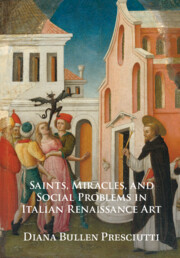Book contents
- Saints, Miracles, and Social Problems in Italian Renaissance Art
- Saints, Miracles, and Social Problems in Italian Renaissance Art
- Copyright page
- Contents
- Figures
- Acknowledgments
- One Introduction
- Two The Vita Icon Reimagined: New (and Old) Saints, New (and Old) Miracles
- Three Storytelling with Saints: Pictorial Narrative and Viewing Experience
- Four Girls in Trouble: Gendering Possession and Exorcism
- Five Assault, Amputation, Absolution: Visualizing the Power of Confession
- Six Thinking with Julian: Marital Violence and Elite Masculinity
- Seven Bernardino the Peacemaker: Visual Hagiography and Factional Violence
- Eight Cannibal Mothers: Picturing Madness and Maternal Infanticide
- Nine Making Innocence Visible (and Audible) in the Basilica del Santo
- Epilogue
- Bibliography
- Index
Two - The Vita Icon Reimagined: New (and Old) Saints, New (and Old) Miracles
Published online by Cambridge University Press: 14 April 2023
- Saints, Miracles, and Social Problems in Italian Renaissance Art
- Saints, Miracles, and Social Problems in Italian Renaissance Art
- Copyright page
- Contents
- Figures
- Acknowledgments
- One Introduction
- Two The Vita Icon Reimagined: New (and Old) Saints, New (and Old) Miracles
- Three Storytelling with Saints: Pictorial Narrative and Viewing Experience
- Four Girls in Trouble: Gendering Possession and Exorcism
- Five Assault, Amputation, Absolution: Visualizing the Power of Confession
- Six Thinking with Julian: Marital Violence and Elite Masculinity
- Seven Bernardino the Peacemaker: Visual Hagiography and Factional Violence
- Eight Cannibal Mothers: Picturing Madness and Maternal Infanticide
- Nine Making Innocence Visible (and Audible) in the Basilica del Santo
- Epilogue
- Bibliography
- Index
Summary
In 1451, the painter Giovanni da Modena completed a large painted canvas featuring St. Bernardino of Siena surrounded by nine small scenes set in illusionistic niches (Fig. 4).1 Bernardino, who had been canonized just the previous year, holds a staff topped with his IHS trigram and wears the signature gray habit and zoccoli (wood-soled sandals) of the Observant Franciscans.2 Eight of the scenes depict Bernardino performing miracles, both in vita and posthumously; the ninth scene, at the bottom left, presents the so-called three crowns – three white miters representing the three bishoprics refused by the saint.3 Although the patron and original function of the painting are debated, it seems most likely that it was commissioned by the Franciscans of Bologna and displayed in an accessible part of their home church of San Francesco, probably on the now-lost tramezzo (rood screen).4
- Type
- Chapter
- Information
- Publisher: Cambridge University PressPrint publication year: 2023

